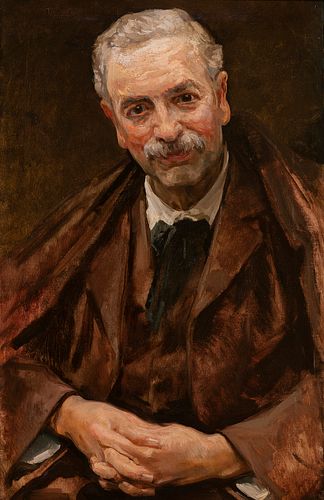Spanish school; late nineteenth century. "Caballero". Oil on canvas.
Lot 67
About Seller
Setdart Auction House
Carrer Aragó 346
Barcelona
Spain
Setdart Subastas was born in 2004 and is currently the first online art auction in Spain with solidity, prestige and reliability guaranteed by our more than 60,000 users. Setdart has a young, dynamic and enterprising team ready to successfully manage the purchase and sale of art works through custom...Read more
Estimate:
EUR€2,500 - EUR€3,000
$2,688.17 - $3,225.81
Absentee vs Live bid
Two ways to bid:
- Leave a max absentee bid and the platform will bid on your behalf up to your maximum bid during the live auction.
- Bid live during the auction and your bids will be submitted real-time to the auctioneer.
Bid Increments
| Price | Bid Increment |
|---|---|
| EUR€0 | EUR€10 |
| EUR€200 | EUR€25 |
| EUR€500 | EUR€50 |
| EUR€1,000 | EUR€100 |
| EUR€3,000 | EUR€200 |
| EUR€5,000 | EUR€500 |
| EUR€10,000 | EUR€1,000 |
| EUR€20,000 | EUR€2,000 |
| EUR€50,000 | EUR€5,000 |
About Auction
By Setdart Auction House
Nov 10, 2021
Set Reminder
2021-11-10 08:00:00
2021-11-10 08:00:00
America/New_York
Bidsquare
Bidsquare : 19th & 20th Century paintings and Decorative Arts
https://www.bidsquare.com/auctions/setdart-auction-house/19th-20th-century-paintings-and-decorative-arts-7800
Setdart Auction House sofia@setdart.com
Setdart Auction House sofia@setdart.com
- Lot Description
Spanish school; late nineteenth century. "Caballero". Oil on canvas. It has a frame from the early twentieth century. Measurements: 66.5 x 41 cm; 87 x 78 cm (frame). Although the work uses certain technical aspects inherited from the portrait tradition, such as, for example, the representation of the long bust slightly turned, a neutral background, and a chromatic range based on ochre or earth tones, the author introduces a completely new way of using the brush. He uses broad brushstrokes that he finishes off with strokes to define the character's physiognomy. Another remarkable aspect of the work, is the posture of the protagonist who is with his hands intertwined, slightly inclined. An attitude that denotes a certain closeness to the viewer, thus providing a friendlier vision and fleeing from the rigidity and sobriety of the portraits. In the 19th century, the panorama of European portraiture was varied and broad, with numerous influences and largely determined by the taste of both the clientele and the painter himself. However, in this century a new concept of portraiture was born, which would evolve throughout the century and unify all the national schools: the desire to capture the personality of the human being and his character, beyond his external reality and his social rank, in his effigy. During the previous century, portraiture had become consolidated among the upper classes, and was no longer reserved only for the court. For this reason, the formulas of the genre, as the 17th century progressed and even more so in the 18th century, became more relaxed and moved away from the ostentatious and symbolic official representations typical of the Baroque apparatus. On the other hand, the 19th century will react against the rigid etiquette of the previous century with a more human and individual conception of life, and this will be reflected in all areas, from the furniture that becomes smaller and more comfortable, replacing the large gilded and carved furniture, to the portrait itself, which will come to dispense, as we see here, of any symbolic or scenographic element to capture the individual instead of the character.
- Shipping Info
-
In-house shipping available. Please inquire at admin@setdart.com.
-
- Buyer's Premium



 EUR
EUR CAD
CAD AUD
AUD GBP
GBP MXN
MXN HKD
HKD CNY
CNY MYR
MYR SEK
SEK SGD
SGD CHF
CHF THB
THB














